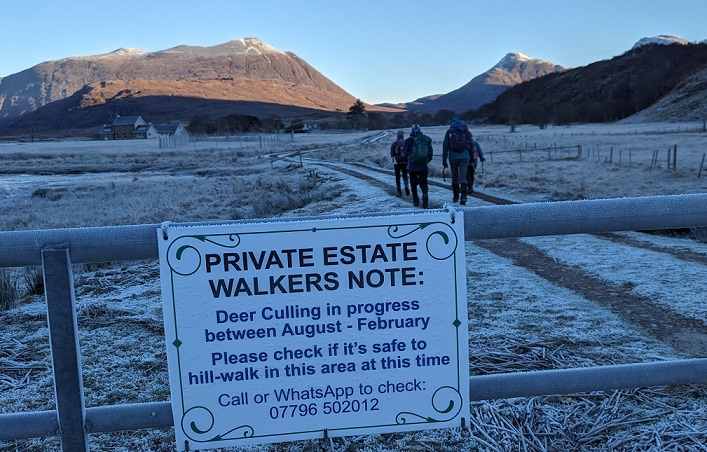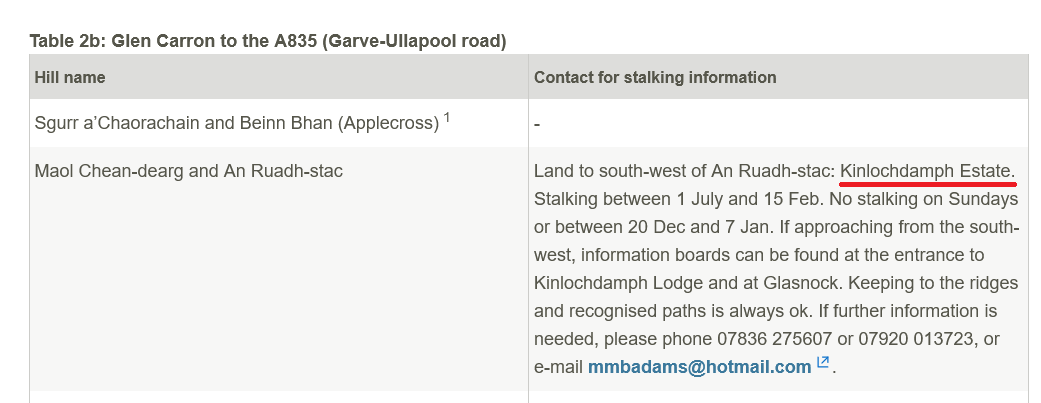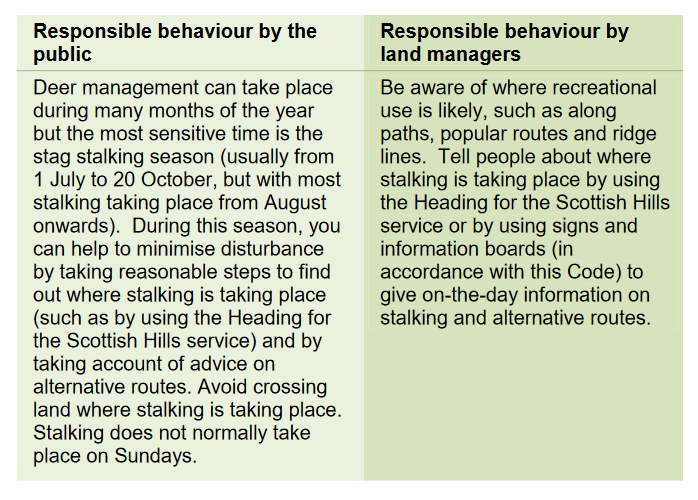
Soon after suggesting that sporting estates managed for grouse pose the greater threat to access rights because of their concerted attempts to make people “keep to the path” (see here), I came across this salutary reminder that some deer stalking estates are still ignoring the Scottish Outdoor Access Code (SOAC).
One of the primary meanings of the word “private” given by the Oxford English Dictionary is:
“Not open to the public, restricted or intended only for the use of a particular person or persons”
Access rights apply equally to both public and private land so why would any sporting estate want to inform walkers that the land is “private”? Unless of course they wanted people to start to doubt their right to be on the land.
At best use of the word “private” serves to confuse, muddling the difference between land exempt from access rights, such as gardens which are indeed “private” as in the OED’s definition, and other land, which may be privately owned but where people have the right to roam.
The request from the estate to check whether its safe to hill-walk between August and February serves as a further deterrent to people wishing to exercise their right to roam. By asking the estate whether it was “safe to hill walk in this area at this time” we would have been accepting the estate’s rights to take decisions about how and when access rights are exercised for six months of the year. We didn’t. But then our party was aware that the legal responsibility is on the estate to ensure that deer culling is undertaken safely, not on the walker to avoid areas where stalking is taking place.

Any fearful hillwalker who had walked past the Couldoran sign in July thinking they were safe to do so before August, might well then come across this sign from the Kinlochdamph Estate stating high velocity rifles are in use from 1st July. Walkers welcome but beware! It reminds me of the old “Danger Adders” signs designed to make the less knowledgeable fearful.
Interestingly the words on the sign contradict the advice given by the Kinlochdamph Estate on the Heading for the Scottish Hills website managed by Mountaineering Scotland and NatureScot (see here):

So why didn’t the signs repeat what the estate had told NatureScot and Mountaineering Scotland? Any slightly fearful walker who like us had followed a track and then a ridge for most of their walk would have had no need to worry about being shot after all and should have felt no need to contact the estate.
But perhaps this sign was erected to impress prospective purchasers of the Kinlochdamph Estate which was put up for sale last year through Goldsmith and Co, the “Exclusive and Independent” Estate Agents (see here)? Exclusivity is of course associated with privilege and privacy. Whatever the explanation, this and the preceding sign are clearly contrary to the advice on Deer Stalking and Public Access produced by the National Access Forum (NAF) (see here) :
“Signs should be welcoming, and should not discourage access by implying a hazard to hillwalkers, as responsibility for the safe use of firearms rests with the stalker”.
That advice needs to be enforced and I have reported the signs to Highland Council, the responsible access authority.
On 21st October 2023 the closed season for shooting the males of all species of deer in Scotland was abolished. This means that stag stalking can now take place year round. The obvious risk is that some estates will use this as an opportunity to try and deter access year to erect signs stating that high velocity rifles are in use January to December. That makes it even more important that existing signs, such as those featured here, are removed as per the National Access Forum Guidance.
The scope of the Heading for the Scottish Hills website has been expanded to reflect the change in the law and that deer culling can now take place year round (and at night) (see here). It will be interesting to see how estates respond but the situation is likely to become more complicated, with some estates likely to restrict stag stalking to short periods while others may stalk at any time (particularly if the price is right).
While the NAF advice on Deer Stalking and Public Access remains as relevant as ever, the extract from the SOAC quoted in it that refers to the stalking season requires updating, as does the SOAC itself:

This could provide an opportunity for the NAF to strengthen its advice and clearly state that signs which claim land where access rights apply is private are unacceptable, as are signs which imply it might be unsafe for walkers to exercise those rights because of deer stalking. What is the likelihood of our National Park Authorities, which share a place on the NAF, taking a lead on this?
It is worth adding that there are many stalking estates and deer stalkers whose practice and respect for access rights is exemplary. A few years ago Dave Morris (one of the architects of our access legislation) and I decided to walk down the north west slopes of Cranstackie, instead of returning by its north ridge to the col between it and Beinn Spionnaidh. A third of the way down we spotted a stalking party below. We decided the best thing to do was to continue down to them and apologise. The stalker couldn’t have been nicer, explained he had seen us and we had not spoilt their day. His paying clients, who had made the journey from the south of England to shoot a deer, accepted this without question. We then asked if we could help and on the stalkers advice changed our intended route to help move the deer in a place where the stalking party could shoot them.
The underlying reason for signs such as those featured in this post is not because public access poses any serious risk to the ability of professional stalkers to shoot deer – they are well capable of working around walkers – but because a large part of the attraction of owning a sporting estate is about joining an exclusive club. Hence the continued desire to restrict access 21 years after the Land Reform (Scotland) Act was passed.

When consideration is given to how much trouble the MOD goes to to ensure people stay out of training areas where live rounds are being used, it is hard to see why this level of notification does not extend to areas where high powered civilian rifles are in use. ( Notices on entry points and for longer closures advance notice given in the local press. )
Should some new access law specify that red flags must be raised each day- and removed overnight- on shooting estates adjacent to locaities in which stalking is taking place, this would have two effects. First it would place a cost burden on land Owners to maintain and effectively “flag” danger areas,…… on each hunting day ….only. Second, it would place a fresh duty of care on the hunting team as they head out on the ground to erect flags to ensure the public had been given the opportunity to observe that day’s flag? ( It wouldappear to be sufficient Grounds for litigation if such a legislated notification requirement was ever flouted ? )
Hi Tom, I think MOD land and hunting estates are totally different, the MOD are often shooting/shelling a large area, sometimes not in sight, where what a stalker is doing is far more specific and in plain sight, Nick
Another silly moan is it not a good idea to warn walkers about the use of powerfull rifles or not to randomly wonder disturbing wildlife the main issue with capercallie is disturbence surly such sign will cut down on wasted police time with random report of men with guns
I didn’t read this as a silly moan, rather as an encouragement of consistency and clarity in communication from the estate to walkers.
Overall Nick, another very helpful and relevant post, thank you.
Jeremy feels Michals comments i s just a silly m,oan. Well,I think these ntices are more signficant than that. when it come to tjhe use of firemarms in hunmitng or in any other situation, the legal reequirement is that the user must ensure they are not a danger to otheres. If you post a notice warning others warning against the danger of being shot by you hunting simply by you walking over open terrain, then you are admitting you are failling to meet that legal obligation. It is like farmers who put up notices saying Beware of the Bull,, not realising that, if anyone is injured by the bull, they have openly admitted they have left a dangerout animal on the loose.
Danger from hunters is a real problem in some parts of the world – eg Itally and most famuosly in USA. Some may recall the words of Tom Lehrers song detailing his yield from a hunting session
“Two hunters. sevem wardens and a pure bred Guernsay cow!
The law was very firm it took away my permit
The worst penalty a hunter can endure.
It appears there was a reason, cows were out of season
And one of the hunters wasn’t ensured!”